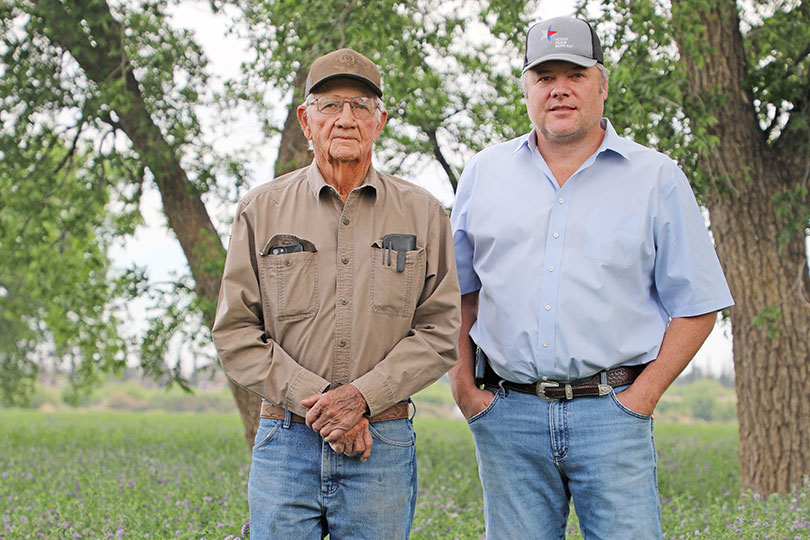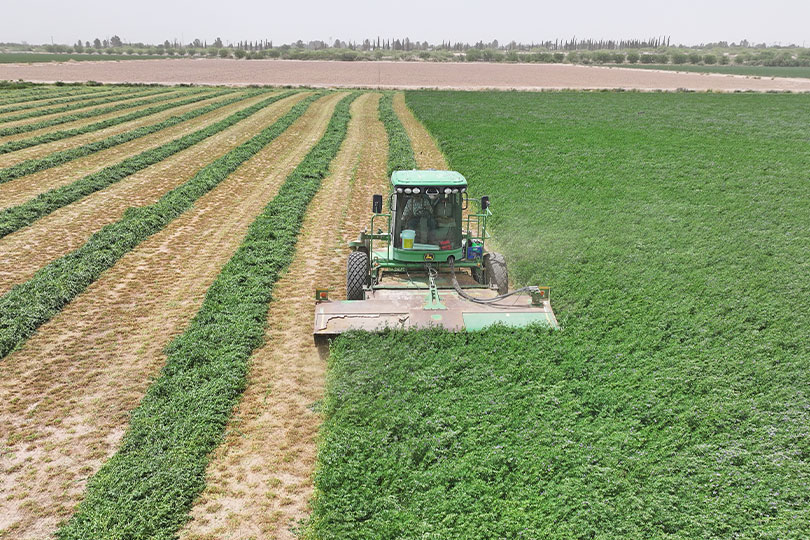By Shelby Shank
Field Editor
In the high desert heat of Far West Texas, where cotton stretches white across the fields and pecan trees sway under the sun, there’s another crop making its mark—alfalfa.
Just a stone’s throw away from the Rio Grande in Fabens, Robert “Bobby” Lettunich and his sons grow cotton, pecans and alfalfa. While cotton and pecans remain central to the farm’s operation, alfalfa has emerged as a staple crop for the family.
The work begins in the fall when the alfalfa is planted, and the first cutting takes place in May.
“After we cut it, rake it and bale it, it’ll be about five to six weeks in between each cut,” Brandon Lettunich, one of Bobby’s sons, said. “We have to irrigate it a couple of times.”
They average seven cuttings each year on the 250 acres of alfalfa.
The region’s dry climate is ideal for growing alfalfa, allowing the crop to be harvested at optimal moisture levels.
“You typically see alfalfa in the western states like Colorado, Arizona and parts of Texas where it’s drier,” Brandon said. “Too much humidity and rain can make it difficult to bale properly and impacts the nutrients.”
The timing of each cut is carefully monitored.
“You know it’s ready to be cut when the alfalfa is about 20% bloomed,” Bobby said.
A swather cuts and lays the alfalfa into rows while crimping the stems to help it dry faster.
Proper curing is crucial. Wet stems can lead to mold or spoilage inside the bales.
“Once the alfalfa has been cut, you have to let it cure for four to five days,” Brandon said. “And of course you keep your fingers crossed because you don’t want it to rain.”
Once the crop reaches the ideal moisture level, the rows are raked, and a baler compresses the alfalfa into large, one-ton bales.
“The best time to bale the crop is at night,” Bobby said. “That’s when moisture rises slightly, keeping the leaves intact while the stems stay dry enough to store.”
Baling at night helps preserve the protein-rich leaves, which are essential for dairy cattle nutrition. If the crop is baled too dry, the leaves can become brittle and break off, reducing the nutritional value. But excessive moisture can also create an undesirable product. When it’s too damp, mold becomes a threat.
The one-ton bales are loaded onto semi-trucks and hauled to a dairy in Hudspeth County, where the high-protein forage serves as a feed source for dairy cattle.
“It’s a nice crop to have in the summer because you get so many cuttings from it,” Brandon said. “It aids our ability to have cash flow throughout the year, as opposed to waiting until the end of cotton harvest or pecan harvest.”
But farming in this part of Texas comes with added challenges.
“We’re literally farming on the border. Our land backs right up to the levee, the floodplain, and then the Rio Grande,” Brandon said. “Mexico is less than half a mile away. It’s a good area to farm, but being this close comes with challenges like illegal crossings in the past and losing 130 acres when the county condemned the land for a port of entry. Still, we’ve made it work.”
Making it work also means managing limited water resources in a time of prolonged drought.
They rely on flood irrigation from the Elephant Butte Reservoir in New Mexico, which was built as part of a federal reclamation project in the early 1900s.
“In a full water year, you’re entitled to up to four-and-a-half acre-feet of water for every acre you farm,” Brandon said. “But we haven’t had that in years. We need snowmelt in Colorado to fill up the dam, and we’ve been in drought conditions since about 2003.”
That scarcity has forced the family to make difficult choices.
“When we’re in a drought year with a low water allotment, we lay out our cotton ground so we can put more water on alfalfa and our pecan orchards,” Brandon said. “You can transfer water from one field to another through the district system, allowing us to keep high-value crops like alfalfa irrigated.”
The region typically receives around seven inches of rainfall annually, but recent totals have been significantly lower.
“Over the last two years, we’ve had maybe two or three inches annually,” Brandon said. “We’ll usually get a monsoon in July or August, but it’s not reliable.”
Even so, the Lettunich family continues to carve out a living—cutting, curing and baling one alfalfa crop at a time—turning dust into green in the desert sun.



Leave A Comment